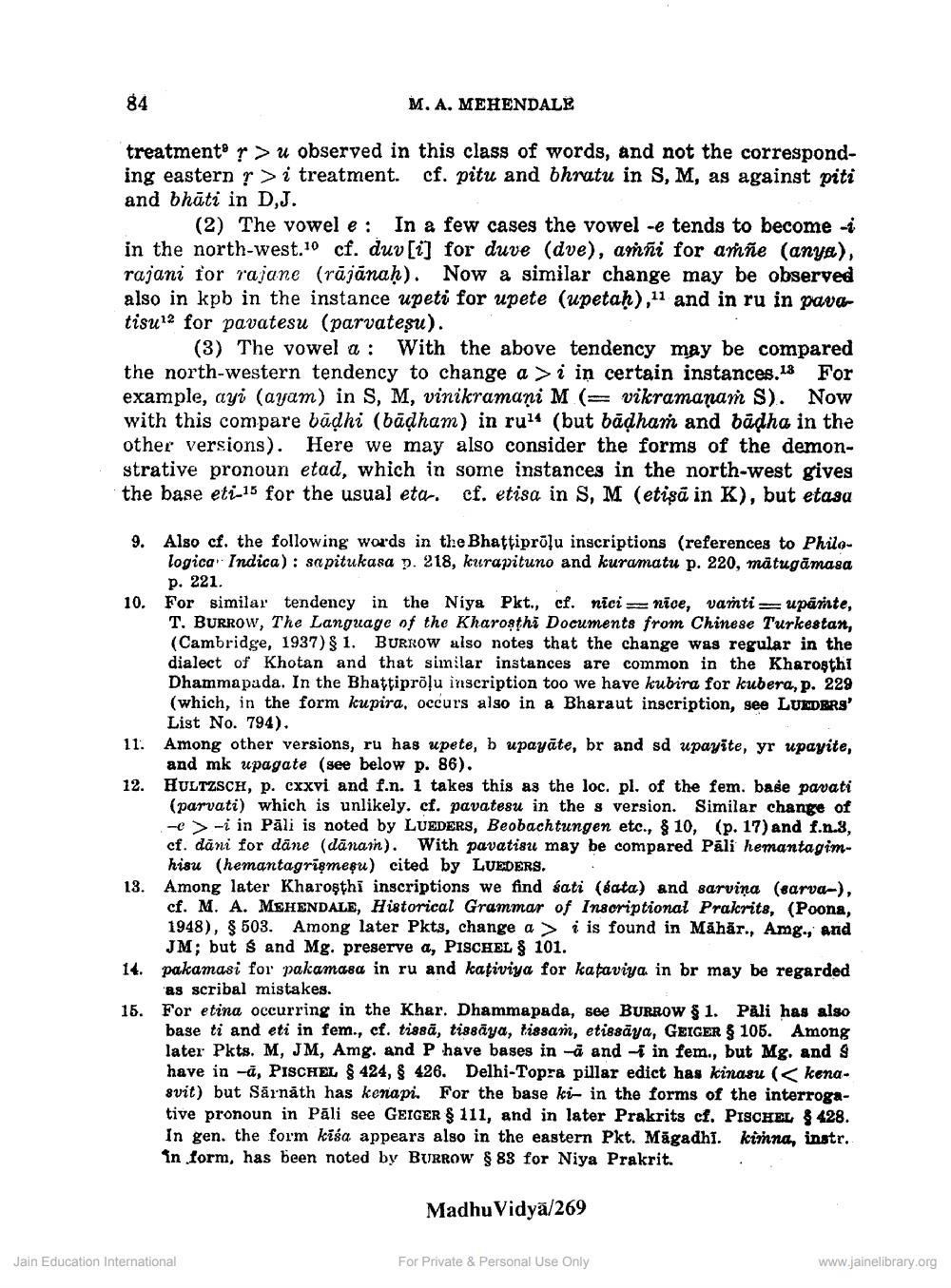________________
84
M.A. MEHENDALE
treatment ?>u observed in this class of words, and not the corresponding eastern ? > i treatment. cf. pitu and bhratu in S, M, as against piti and bhāti in D,J.
(2) The vowel e: In a few cases the vowel -e tends to become - in the north-west 10 cf. duv[i] for duve (dve), amni for amñe (anya), rajani for rajane (rājānah). Now a similar change may be observed also in kpb in the instance upeti for upete (upetah),11 and in ru in pavatisu12 for pavatesu (parvatesu).
(3) The vowel a: With the above tendency may be compared the north-western tendency to change a >i in certain instances.18 For example, ayi (ayam) in S, M, vinikramaņi M(= vikramanan s). Now with this compare būdhi (badham) in rull (but bâdhan and badha in the other versions). Here we may also consider the forms of the demonstrative pronoun etad, which in some instances in the north-west gives the base eti_15 for the usual eta-. cf. etisa in S, M (etişã in K), but etasa
9. Also cf. the following words in the Bhattiprālu inscriptions (references to Philo
logica Indica): sapitukasa p. 218, kurapituno and kuramatu p. 220, mátugāmasa
p. 221. 10. For similar tendency in the Niya Pkt., cf. nicinioe, vanti = uparte,
T. BURROW, The Language of the Kharosthi Documents from Chinese Turkestan, (Cambridge, 1937) S 1. BURROW also notes that the change was regular in the dialect of Khotan and that similar instances are common in the Kharosthi Dhammapada. In the Bhattiprāļu inscription too we have kubira for kubera, p. 229 (which, in the form kupira, occurs also in a Bharaut inscription, gee LURDERS'
List No. 794). 11. Among other versions, ru has upete, b upayāte, br and sd upayite, yr upayite,
and mk upagate (see below p. 86). 12. HULTZSCH, p. cxxvi and f.n. 1 takes this as the loc. pl, of the fem. base pavati
(parvati) which is unlikely. cf. pavatesu in the s version. Similar change of -e > -i in Pāli is noted by LUEDERS, Beobachtungen etc., $ 10, (p. 17) and f.n.3, cf. dāni for dāne (dānan). With pavatisu may be compared Pāli hemantagimhisu (hemantagrīşmeşu) cited by LUEDERS. . Among later Kharoşthi inscriptions we find sati (sata) and sarvina (sarva-), cf. M. A. MEHENDALE, Historical Grammar of Inscriptional Prakrits, (Poona, 1948), $ 503. Among later Pkts, change a > i is found in Măhăr., Amg., and
JM; but s and Mg. preserve a, PISCHEL 8 101. 14. pakamasi for pakamasa in ru and kațiviya for kataviya in br may be regarded
as scribal mistakes. 15. For etina occurring in the Khar. Dhammapada, see BURROW & 1. Pali has also
base ti and eti in fem., cf. tiesā, tissāya, tissam, etissäya, GEIGER 8 105. Among later Pkts. M, JM, Amg. and P have bases in -, and 1 in fem., but Mg, and have in -ă, PISCHEL § 424, $ 426. Delhi-Topra pillar edict has kinasu (< kena. svit) but Särnáth has kenapi. For the base ki- in the forms of the interrogative pronoun in Pāli see GEIGER $ 111, and in later Prakrits cf. PISCHEL 428. In gen. the form kisa appears also in the eastern Pkt. Măgadhi. kinna, instr. in form, has been noted by BURROW $83 for Niya Prakrit.
13.
Madhu Vidyā/269
Jain Education International
For Private & Personal Use Only
www.jainelibrary.org




